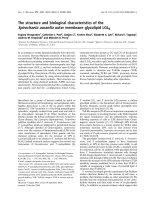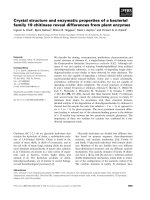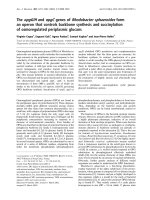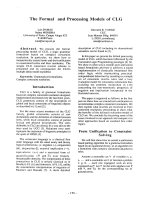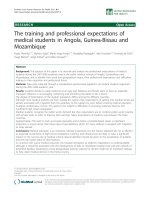Báo cáo toán học: " The structural and optical properties of GaSb/InGaAs type- quantum dots grown on InP (100) substrate" ppt
Bạn đang xem bản rút gọn của tài liệu. Xem và tải ngay bản đầy đủ của tài liệu tại đây (208.88 KB, 12 trang )
This Provisional PDF corresponds to the article as it appeared upon acceptance. Fully formatted
PDF and full text (HTML) versions will be made available soon.
The structural and optical properties of GaSb/InGaAs type- quantum dots grown
on InP (100) substrate
Nanoscale Research Letters 2012, 7:87 doi:10.1186/1556-276X-7-87
Zhang Shuhui ()
Wang Lu ()
Shi Zhenwu ()
Cui Yanxiang ()
Tian Haitao ()
Gao Huaiju ()
Jia Haiqiang ()
Wang Wenxin ()
Chen Hong ()
Zhao Liancheng ()
ISSN 1556-276X
Article type Original paper
Submission date 19 September 2011
Acceptance date 25 January 2012
Publication date 25 January 2012
Article URL />This peer-reviewed article was published immediately upon acceptance. It can be downloaded,
printed and distributed freely for any purposes (see copyright notice below).
Articles in Nanoscale Research Letters are listed in PubMed and archived at PubMed Central.
For information about publishing your research in Nanoscale Research Letters go to
/>For information about other SpringerOpen publications go to
Nanoscale Research Letters
© 2012 Shuhui et al. ; licensee Springer.
This is an open access article distributed under the terms of the Creative Commons Attribution License ( />which permits unrestricted use, distribution, and reproduction in any medium, provided the original work is properly cited.
The structural and optical properties of GaSb/InGaAs type-II
quantum dots grown on InP (100) substrate
Zhang Shuhui
1,2
, Wang Lu*
2
, Shi Zhenwu
2
, Cui Yanxiang
2
, Tian Haitao
2,3
, Gao
Huaiju
2
, Jia Haiqiang
2
, Wang Wenxin
2
, Chen Hong
2
, and Zhao Liancheng*
1
1
School of Materials Science and Engineering, Harbin Institute of Technology, Harbin,
150001, China
2
National Laboratory for Condensed Matter Physics, Institute of Physics, Chinese
Academy of Sciences, Beijing, 100190, China
3
Engineering Research Center of Solid-State Lighting, School of Electrical
Engineering and Automation, Tianjin Polytechnic University, Tianjin, 300160, China
*Corresponding authors: ;
Email addresses:
ZS:
WL:
SZ:
CY:
TH:
GH:
JH:
WW:
CH:
ZL:
Abstract
We have investigated the structural and optical properties of type-II GaSb/InGaAs
quantum dots [QDs] grown on InP (100) substrate by molecular beam epitaxy.
Rectangular-shaped GaSb QDs were well developed and no nanodash-like structures
which could be easily found in the InAs/InP QD system were formed.
Low-temperature photoluminescence spectra show there are two peaks centered at
0.75eV and 0.76ev. The low-energy peak blueshifted with increasing excitation power
is identified as the indirect transition from the InGaAs conduction band to the GaSb
hole level (type-II), and the high-energy peak is identified as the direct transition
(type-I) of GaSb QDs. This material system shows a promising application on
quantum-dot infrared detectors and quantum-dot field-effect transistor.
Introduction
Quantum-size nanostructure materials have always been the research focus
[1-5]. In recent years, staggered lineup type-II quantum-size nanostructures are of
great research interest due to their possible application in many novel devices [6, 7].
Notably, a large research effort has been focused on the type-II quantum-size
nanostructures composed of III and V direct-bandgap semiconductor materials, such
as GaSb/GaAs [8-10], InAlAs/InP [11], InP/InGaP [12, 13], InP/GaAs [14],
GaAsSb/GaAs [15], and InAs/GaSb [16, 17]. The reason is that they offer
comparatively large bandgap energies and provide a possibility of covering the whole
middle and far-infared optical range for photoelectric devices. Among these material
systems, GaSb/GaAs quantum dot [QD] is an outstanding representative since its
giant valence band offset, characteristic to this system, may result in practical
applications for light-emitting devices in the spectral range of 1 to approximately 1.5
µm, such as in ophthalmology, neurology, and endoscopy [18].
Here, we provided another type-II QD material system, GaSb/InGaAs/InP, as
another promising building block for optoelectronic and microelectronic applications.
Compared to GaSb/GaAs type-II QDs, the bandgap of this system can be adjusted by
both the QD-relevant structural characteristics and the In component in a InGaAs
matrix. InP substrate is employed instead of GaAs for two reasons: one is that the
lattice of InP is matched with the InGaAs buffer layer which has higher electron
mobility; the other is that it may make the absorption peak position easily red shifted
to 1.3 to approximately 1.55 µm. All these features show a promising application on
the quantum-dot infrared detectors [QDIP] and quantum-dot field-effect transistors
[QD-FET].
In this work, we investigated the structural and optical properties of type-II
GaSb/InGaAs QDs grown on InP (100) substrate using molecular beam epitaxy
[MBE].
Experiments
GaSb/InGaAs type-II QDs were grown on the (100) semi-insulation Fe-doped
InP substrate by a V80 MBE system (VG Semicon, East Grinstead, Weat Sussex, UK).
The growth mode followed is the Stranski-Krastanow [SK] mode. Firstly, the surface
oxides of the InP substrate were desorbed at a substrate temperature of approximately
500°C. A 500-nm In
0.53
Ga
0.47
As buffer layer matched with the InP substrate was then
deposited at a growth rate of 5,000Å/h. Four-monolayer [ML] GaSb QDs were
deposited with a slow growth rate of 0.12 ML/s. There was a 3-min growth
interruption before and after QD growth. Afterwards, a 30-nm In
0.53
Ga
0.47
As capping
layer was grown at a rate of 5,000Å/h. A 50-nm In
0.52
Al
0.48
As barrier layer was grown
at a rate of 5,300Å/h. Finally, GaSb QDs were grown for the surface morphology
measurements. The growth temperature used for the whole growth process was
approximately 480°C. In the growth process of the sample, the InGaAs capping layer
was doped with Si.
The morphology measurements of the QDs were characterized by a atomic force
microscopy [AFM] and a scanning transmission electron microscope [STEM]. The
AFM measurements were conducted in a tapping mode in air, and the STEM
measurements were obtained using a Tecnai F20 super-twin machine (FEI Co.,
Hillsboro, OR, USA). The photoluminescence [PL] measurements were performed for
the optical properties of the sample at 20 K using the source of a 532-nm line, and the
excitation power is changed from 3 mW to 30 mW.
Results and discussion
In order to characterize the density, shape, diameter, and height size distribution
of GaSb/ InGaAs QDs on InP (100) substrate, the AFM and STEM measurements
were carried out. Figure 1 shows the AFM and STEM images of GaSb/In
0.53
Ga
0.47
As
QDs and the histogram of the height of GaSb/In
0.53
Ga
0.47
As QDs. As shown in Figure
1a, the statistical data indicate that the density of the QDs is approximately 7 × 10
9
cm
−2
and that the shape of GaSb QDs is rectangular-shaped which is the same with
GaSb/GaAs QDs [9]. Figure 1b shows the height distribution of the
GaSb/In
0.53
Ga
0.47
As QDs. From the figure, we can see that the height of the quantum
dots is mainly concentrated to approximately 6 nm. Due to the well known ‘tip effect’
of AFM, the results of AFM measurements cannot describe the precise lateral size of
the QDs. The STEM measurements were used to image the configuration for
overcoming this limitation of AFM measurements. Figure1c shows that the lateral size
of the QDs is approximately 40 nm. The results indicate that the rectangular-shaped
GaSb/InGaAs QDs are well developed in the SK growth mode, but no nanodash-like
structures which are easily found in the InAs/InP QD system were formed [19].
However, there seemed to be some smaller QDs (the lateral size was about 20 nm) in
the AFM image. By measuring the height distribution of the QDs, we observed that
they were lower than 2 nm. We did not observe such bimodal distribution in the
STEM images. So, we thought that these mound-like structures were possibly from
the non-optimized InGaAs buffer layer. Another possible explanation was that the
formation of the InGaAsSb wetting layer resulted in the accumulation of individual
atoms on the surface to form a mound-like structure, due to the intermixing of As and
Sb during the growth of GaSb QD.
Figure 2 shows the PL spectra of four-ML QDs at 20 K with an excitation power
of 3mW. It is obvious that there are two peaks centered at 0.75eV and 0.76eV,
respectively. For identifying these two peaks, low-temperature excitation
power-dependent PL spectrum tests were carried out, and the results were shown in
Figure 3a. Figure 3b shows the PL peak energies with various excitation powers. It is
obvious that the low-energy peak blueshifts with the increasing excitation power,
while the position of the high-energy peak is almost constant. The PL peak blueshifts
with increasing excitation power is a special character of type-II heterostructures. The
other supporting evidence of the type-II luminescence is the linear dependence of the
PL peak energies over the third root of the excitation density [20]. The inset of Figure
3b shows the linear dependence of the PL peak energies and the third root of the
excitation power. Many researchers attributed the high energy PL peak to the
transition of the wetting layer [9, 10, 21]. In these references, there is a common point
where the wetting layer peak blueshifts also with increasing excitation power (type-II).
However, the high-energy peak in our work is almost independent of the excitation
power which is a typical feature of the type-I band transition. Therefore, the interband
transition of the GaSb QD would be the only proper origin of the high-energy peak. In
the growth process of the sample, the InGaAs cap layer was doped with Si. Because
the dope concentration was relatively high, the Fermi level of the InGaAs layer may
possibly be higher than the bottom of the conduction band of GaSb QDs. In such
circumstance, the light emission intensity of the GaSb QD could be stronger than the
type II transition due to the stronger spatial confinement of carriers in the QD and the
nature of the direct transition type I transition. It may be the reason that the PL
intensity of the direct interband transition (type I) was strong as observed in the
experiment. So, these two peaks are identified as the indirect transition from the
InGaAs conduction band to the GaSb hole level (type-II) and the GaSb QDs direct
interband transition (type-I) respectively, as shown in Figure 4a.
To explain the PL mechanisms of the type-II GaSb/InGaAs QD structures, the
schematic band diagrams of GaSb/InGaAs heterostructures are provided in Figure 4b.
The spatial separation of electrons and holes will produce an electric field near the
type-II GaSb/InGaAs interface. This electric field could make the band bended and
form approximately triangular wells adjacent to the heterojunction. With increasing
excitation power, the accumulation of electrons and holes at the GaAs/InGaAs
interface would steepen the wells. In this case, upraised energy levels in the
approximately triangular wells of electrons and holes would cause the PL peak to
blueshift.
As is well known, the GaSb QDs only confine the holes, while the electrons are
confined in the InGaAs matrix in the type-II GaSb /InGaAs QD heterostructure. We
can take advantage of these features to accomplish a charge-discharge process of QDs
and then to modulate the electric property of a two-dimensional electron gas [2DEG]
in QD-FET. In this kind of QD-FET structure, type-II GaSb/InGaAs QDs are
embedded; even if the GaSb QDs directly contacts with the 2DEG, electrons will still
be blocked by the GaSb barrier and will not enter the QDs. Therefore, this structure
will prolong the lifetime of the holes. So, the QD-FET based on the above band
structure can be used to improve the sensitivity of existing InAs/GaAs QD-FET. In
addition, this material system can be fabricated on InP substrates. The higher electron
mobility InGaAs light absorption layer with lattice matched to the InP substrate has a
strong optical absorption in the range of 1.3 to approximately 1.55 µm which is the
low-loss optical fiber window. All of these features will promote the application of
QD-FET on quantum communications, night vision, and other fields. Besides, owing
to the spatially separated electrons and hole characters of type-II QDs, the
GaSb/InGaAs QD-based QDIP could have obviously better performance than the
InAs/(In)GaAs QD-based QDIP.
Conclusion
We have investigated the structural and optical properties of self-organized
type-II GaSb/InGaAs heterostructure QDs grown on InP (100) using MBE. Formation
of type-II GaSb/InGaAs heterostructure QDs centered on the PL peak at 0.75eV at 20
K. This type-II luminescence originates from radiative recombination of spatially
separated electrons and holes. The PL peak positions are in proportion to the third root
of the excitation power, which is a direct evidence of type-II luminescence. This
structure was proposed for many important applications such as tunable laser,
quantum-dot infrared detectors, and QD-FET.
Competing interests
The authors declare that they have no competing interests.
Authors' contributions
ZS participated in the MBE growth, carried out the PL measurements, and drafted the
manuscript. CY conducted the STEM measurement. SZ, TH, and GH conducted the
MBE growth. JH, WW, and CH coordinated the study. WL provided the idea and
conceived the study together with ZL. All authors read and approved the final
manuscript.
Acknowledgments
This work was supported by the Natural Science Foundation of China (Grant
Nos. 10874212 and 61106013), the National High Technology Research and
Development Program of China (Grant No. 2009AA033101), and the National Basic
Research Program of China (Grant No. 2010-CB327501).
References
1. Lee JH, Wang ZhM, Liang BL, Sablon KA, Strom NW, Salamo GJ: Size and
density control of InAs quantum dot ensembles on self-assembled
nanostructured templates. Semicond Sci Technol 2006, 21:1547.
2. Wang L, Li M, Wang W, Tian H, Xing Z, Xiong M, Zhao L: Strain accumulation
in InAs/In
x
Ga
1−x
As quantum dots. Appl Phys A 2011, 104:257.
3. Wang ZhM, Seydmohamadi Sh, Lee JH, Salamo GJ: Surface ordering of (In,
Ga)As quantum dots controlled by GaAs substrate indexes. Appl Phys Lett,
2004, 85:5031.
4. Yu V, Vorobiev VR, Vieira PP, Horley PN, Gorley, González-Hernández J:
Energy spectrum of an electron in the hexagon-shaped quantum well. Sci
China Ser E, 2009, 52:15.
5. Liang BL, Wang ZhM, Lee JH, Sablon K, YuI, Mazur, Salamo GJ: Low density
InAs quantum dots grown on GaAs nanoholes. Appl Phys Lett 2006, 89:043113.
6. Kroemer H, Griffiths G: Staggered-lineup heterojunctions as sources of tunable
below-gap radiation: operating principle and semiconductor selection. IEEE
Electron Device Lett 1983, 4:20.
7. Sugiyama Y, Nakata Y, Muto S, Futasugi T, Yokoyama N: Characteristics of
spectral-hole burning of InAs self-assembled quantum dots. IEEE J Sel Top
Quantum Electron 1998, 4:880.
8. Lin S-Y, Tseng C-C, Lin W-H, Mai S-C, Wu S-Y, Chen S-H, Chyi J-I:
Room-temperature operation type-II GaSb/GaAs quantum-dot infrared
light-emitting diode. Appl Phys Lett 2010, 96:123503.
9. Hatami F, Ledentsov NN, Grundmann M, BÖhrer J, Heinrichsdorff F, Beer M,
Bimberg D, Ruvimov SS, Werner P, GÖsele U, Heydenreich J, Richter U, Ivanov
SV, Meltser BYa, Kop’ev PS, Alferov ZhI: Radiative recombination in type-II
GaSb/GaAs quantum dots. Appl Phys Lett 1995, 67:656.
10. Alonso-Álvarez D, Alén B, García JM, Ripalda JM: Optical investigation of type
II GaSb/GaAs self-assembled quantum dots. Appl Phys Lett 2007, 91:263103.
11. Biihrer J, Krost A, Bimberg D: Carrier dynamics in staggered-band lineup
n-InAlAs-InP heterostructures. Appl Phys Lett 1994, 64:1992.
12. Hayne M, Provoost R, Zundel MK, Manz YM, Eberl K, Moshchalkov VV:
Electron and hole confinement in stacked self-assembled InP quantum dots.
Phys Rev B 2000, 62:10324.
13. Sugisaki M, Ren HW, Nair SV, Nishi K, Masumoto Y: External-field effects on
the optical spectra of self-assembles InP quantum dots. Phys Rev B 2002,
66:235309.
14. Ribeiro E, Maltez RL, Carvalho W Jr, Ugarte D, Medeiros-Ribeiro G: Optical
and structural properties of InAsP ternary self-assembled quantum dots
embedded in GaAs. Appl Phys Lett 2002, 81:2953.
15. Liu G, Chuang S-L, Park S-H: Optical gain of strained GaAsSb/GaAs
quantum-well laser: a self-consistent approach. J Appl Phys 2000, 88:5554.
16. Rodriguez JB, Plis E, Bishop G, Sharma YD, Kim H, Dawson LR, Krishna S:
nBn structure based on InAs/GaSb type-II strained layer superlattices. Appl
Phys Lett 2007, 91:043514.
17. Smith DL, Mailhiot C:Proposal for strained type-II superlattice infrared
detectors. J Appl Phys 1987, 62:2545.
18. Tomlins PH, Wang RK: Theory, developments and applications of optical
coherence tomography. J Phys D: Appl Phys 2005, 38:2519.
19. Lelarge F, Dagens B, Renaudier J, Brenot R, Accard A, van Dijk F, Make D, Le
Gouezigou O, Provost J-G, Poingt F, Landreau J, Drisse O, Derouin E: Recent
advances on InAs/InP quantum dash based semiconductor laser and optical
amplifiers operating at 1.55 µm. IEEE J Sel Top Quantum Electron 2007, 13:111.
20. Hatami F, Grundmann M, Ledentsov NN, Heinrichsdorff F, Heitz R, Böhrer J,
Bimberg D, Ruvimov SS, Werner P, Ustinov VM, Kop’ev PS, Alferov ZhI:
Carrier dynamics in type-II GaSb/GaAs quantum dots. Phys Rev B 1998,
57:4635.
21. Lin T-C, Li L-C, Lin S-D, Suen Y-W, Lee C-P: Anomalous optical magnetic
shift of self-assembled GaSb/GaAs quantum dots. J Appl Phys 2011,
110:013522.
Figure 1. AFM and STEM images of GaSb/In
0.53
Ga
0.47
As QDs and histogram of
the height of GaSb/In
0.53
Ga
0.47
As QDs. (a) The AFM image of GaSb/In
0.53
Ga
0.47
As
QDs, (b) histogram of the height of GaSb/In
0.53
Ga
0.47
As QDs, and (c) the STEM
image of GaSb/In
0.53
Ga
0.47
As QDs.
Figure 2. Low-temperature (20 K) PL spectra of GaSb/ InGaAs QD sample on
InP substrate. Dashed-dot and dashed lines show the PL spectra of type-II and type-I,
respectively.
Figure 3. PL spectra and PL peak energies. (a) The low-temperature PL spectra of
the sample measured under different pumping powers from 3 mW to 30 mW; (b) The
PL peak energies obtained under different excitation powers and the fitting curve of
the peak energies with the third root of the excitation power.
Figure 4. Schematic band diagrams. (a) Bulk GaSb/InGaAs heterostructures and (b)
GaSb/InGaAs QD nanostructures forming approximately triangular wells.
3 4 5 6 7 8 9 10
0
5
10
15
20
25
30
35
Number
The height (nm)
(b)
Figure 1
0.74 0.75 0.76 0.77
Intensity (arb.units)
Energy (eV)
3mw
Figure 2
0.74 0.75 0.76 0.77 0.78
30mW
20mW
10mW
5mW
Intensity (arb.units)
Energy (eV)
3mW
(a)
0 5 10 15 20 25 30
0.750
0.752
0.754
0.756
0.758
0.760
0.762
0.764
Energy (eV)
Power (mW)
high energy peak
low energy peak
(b)
1.5 2.0 2.5 3.0
0.750
0.755
0.760
0.765
low energy peak
fitting curve
Energy (eV)
The Third Root of Excitation Power (mW)
1/3
Figure 3
(a)
(b)
Figure 4

